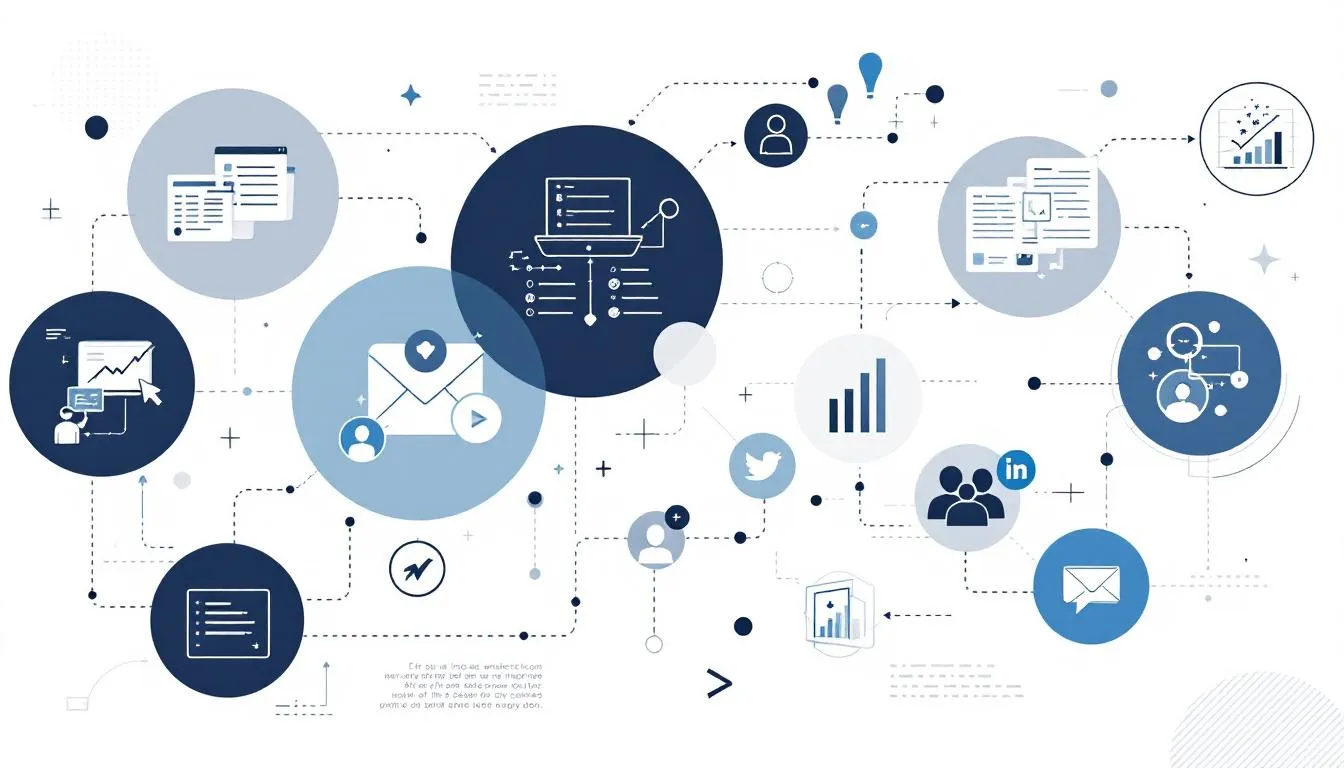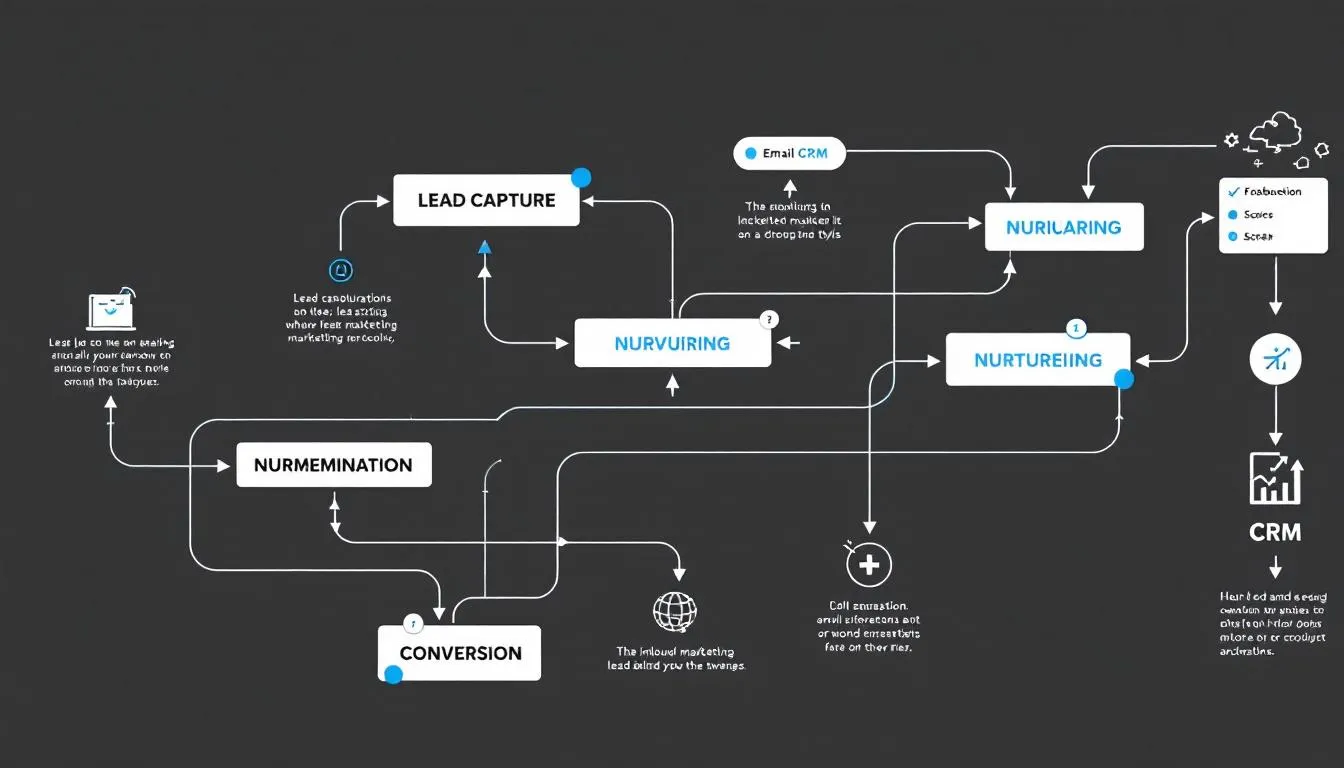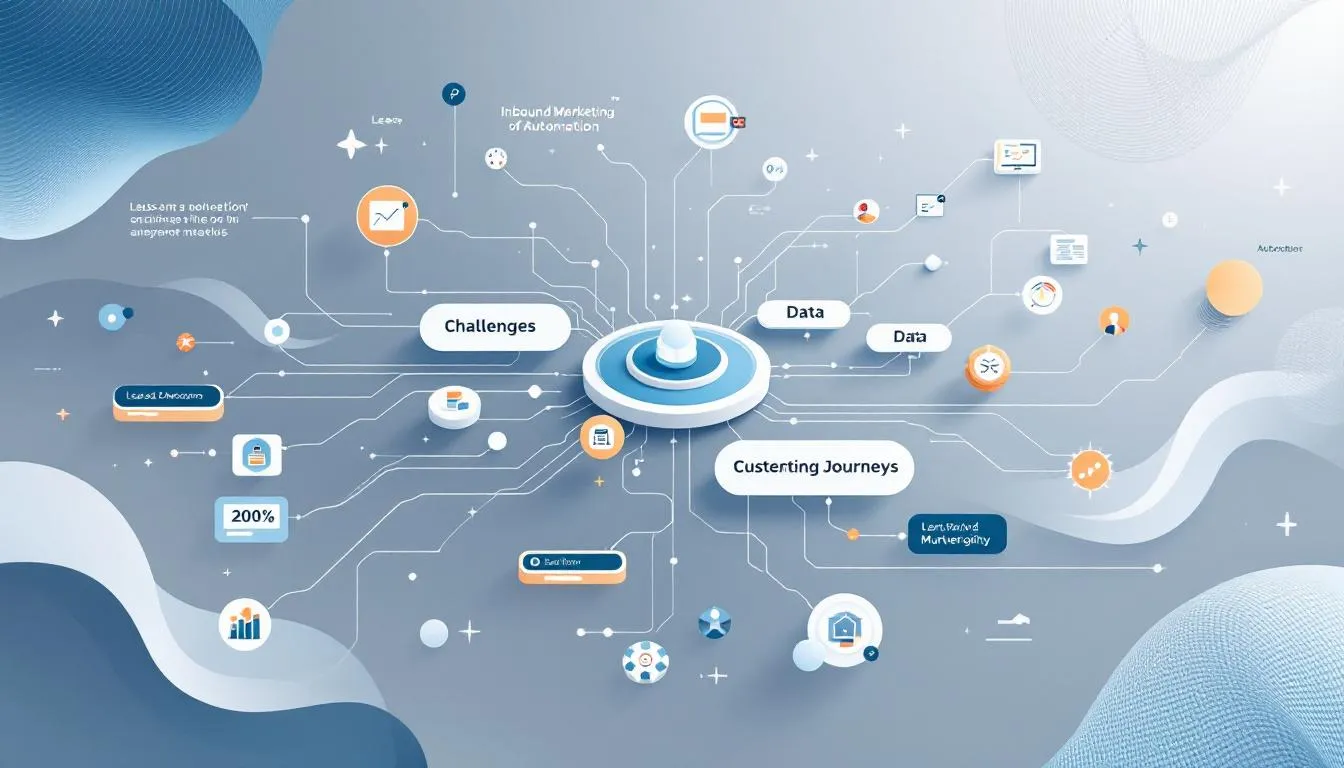Key Takeaways
- Inbound marketing focuses on attracting and retaining customers through valuable content, while marketing automation streamlines repetitive tasks to enhance efficiency.
- Integrating inbound marketing with marketing automation significantly improves lead generation, customer engagement, and overall marketing efficiency, resulting in better ROI.
- Successful implementation of an inbound marketing automation strategy requires clear goals, the right platform, detailed buyer personas, and regular performance monitoring for continuous optimization.
Understanding Inbound Marketing and Marketing Automation

Mastering the basics of inbound marketing and marketing automation unlocks their full potential. Inbound marketing focuses on creating valuable content to attract and retain customers, while marketing automation streamlines repetitive tasks and enhances overall efficiency.
When these two strategies are combined, they create a powerful synergy that drives more effectively market marketing campaigns.
What is Inbound Marketing?
Inbound marketing is all about attracting customers through valuable content and personalized interactions. Unlike outbound marketing, which relies on interruptive tactics, inbound marketing efforts draw potential customers in by addressing their needs and providing solutions through content. The goal is to convert not-ready-to-buy visitors into loyal customers by answering their questions and engaging them throughout their inbound marketing work.
The inbound methodology is a strategic approach that focuses on building lasting relationships with customers by delighting them at every stage. It creates a self-sustaining cycle of attracting new prospects, engaging them with personalized content, and turning inbound leads into a brand advocate through outbound methods.
Focusing on inbound strategies allows businesses to reach and engage their target audiences effectively, building trust and credibility.
What is Marketing Automation?
Marketing automation software automates marketing and sales tasks, simplifying the management of campaigns across multiple digital channels. A robust marketing automation platform includes features that help attract, convert, and delight customers by automating workflows beyond just email marketing. This includes:
- Setting up CTAs
- Capturing leads
- Scheduling social media posts
- Creating blogs and landing pages.
The primary benefit of marketing automation lies in its ability to enhance efficiency and optimize processes. Key advantages include:
- Streamlined lead management
- Nurturing prospects throughout the journey
- Detailed analytics of customer interactions that significantly improve marketing efforts
- Simplified identification of prospects
- Delivery of content based on their stage in the buying process
The Synergy Between Inbound Marketing and Marketing Automation
Inbound marketing and marketing automation are two pieces of the same puzzle. Marketing automation complements inbound marketing strategies by enabling better audience segmentation, timely follow-ups, and personalized communication. This synergy helps determine when prospects are ready to move to the buying phase and ensures that leads are engaged through timely notifications and follow-ups.
Aligning marketing and sales teams maximizes the effectiveness of inbound marketing automation. When these teams work together, it results in more effective lead generation, nurturing, and segmentation, ultimately driving greater customer engagement and business growth. This harmonious integration ensures that marketing efforts are cohesive and aligned with overall business goals.
Key Benefits of Integrating Inbound Marketing with Marketing Automation

Integrating inbound marketing with marketing automation offers numerous benefits that significantly enhance marketing efforts. This powerful combination allows businesses to attract and engage potential customers more effectively, creating a seamless and personalized customer journey.
Automation tools transform inbound marketing initiatives into efficient qualified leads generators and converters.
Enhanced Lead Generation
Inbound marketing aims to convert potential customers into loyal clients. Marketing automation plays a critical role in optimizing lead generation by:
- Driving more leads into the sales funnel quickly and efficiently
- Facilitating personalized communication
- Delivering targeted content
- Enabling timely follow-ups
These factors enhance lead cultivation and conversion rates.
Additionally, marketing automation simplifies lead qualification by fetching visitor data and categorizing leads into different stages of the buyer journey. This targeted approach ensures that leads receive relevant content based on their needs, enhancing the overall effectiveness of lead generation efforts.
Improved Customer Engagement
Combining inbound marketing with automation enhances the efficiency of marketing efforts by personalizing customer interactions. Automated workflows trigger personalized communications based on customer behavior, boosting engagement and fostering loyalty. By maintaining regular contact with customers and guiding them through personalized journeys, businesses can increase customer engagement and trust.
This personalized approach not only improves customer satisfaction but also encourages repeat business and brand loyalty. Through tailored content and interactions, businesses can create deeper connections with their audience, ultimately leading to long-term relationships and increased customer lifetime value, delighting customers.
Increased Efficiency and ROI
Automation significantly reduces the time spent on repetitive marketing tasks, allowing teams to focus on strategic initiatives that drive business growth. By streamlining efforts and segmenting data of leads and prospects, marketing automation tools help businesses maximize their return on investment. This efficiency gain translates into higher productivity and better resource allocation.
Additionally, marketing automation provides valuable insights through analytics and reporting, enabling informed decision-making and continuous optimization of marketing strategies. This data-driven approach ensures that marketing efforts are aligned with business goals and contribute to achieving a favorable ROI.
Implementing an Effective Inbound Marketing Automation Strategy

To implement an effective inbound marketing automation strategy, careful planning is essential. Proper execution is also crucial for success. By defining clear goals, choosing the right platforms, and creating detailed buyer personas, businesses can set the foundation for a successful strategy.
This section provides a step-by-step guide to help you navigate the process.
Setting Clear Goals and Objectives
Clear goals are important for inbound marketing success. They help in achieving a favorable return on investment. Establishing goals that are:
- Specific
- Measurable
- Realistic
- Achievable
Measurable and relevant marketing goals guide the efficiency of marketing efforts and are foundational to a successful inbound marketing strategy.
Choosing the Right Marketing Automation Platform
Selecting the right marketing automation platform is crucial for the success of your inbound marketing strategy. The chosen platform must align with the unique needs of your business and provide relevant features such as reporting, analytics integration, and seamless coordination with existing systems.
Key functionalities like A/B testing and user experience should also be considered to ensure the platform enhances overall marketing efficiency.
Creating Buyer Personas and Audience Segmentation
Effective inbound marketing requires a deeper understanding of customer personas and their specific challenges. Developing detailed buyer personas to create personas enhances the targeting and effectiveness of marketing campaigns by analyzing:
- their information channels
- goals
- challenges
- priorities
Segmentation targets specific target audience with tailored campaigns, and marketing automation platforms help by sending targeted emails to different buyer personas.
Best Practices for Inbound Marketing Automation Workflows

Creating effective workflows is essential for guiding potential customers through the buyer’s journey and the buying process. Utilizing triggers, conditions, and actions in marketing automation can lead to increased efficiency and improved customer journey tracking.
This section discusses best practices for optimizing workflows.
Automated Email Sequences
Automated email sequences can effectively nurture leads through lead nurturing by sending tailored messages at predetermined intervals based on user behavior. Marketing automation platforms like Hubspot facilitate the creation of engagement and re-engagement campaigns using tailored email templates designed for different stages of the buyer journey.
To ensure effective email campaigns, avoid sending generic emails to all recipients and monitor for declining email open rates and deliverability issues.
Personalization and Dynamic Content
Automated marketing personalization tailors messages to individual preferences and demographics. Dynamic content allows marketers to adjust messaging and visuals automatically based on the recipient’s preferences and behaviors, maintaining meaningful customer interactions in automated campaigns.
This approach ensures that compelling content remains relevant and engaging, enhancing overall customer engagement through content marketing and helpful content and branded content.
Monitoring and Optimizing Workflows
Regularly analyzing the performance of automation workflows is crucial for making data-driven adjustments that enhance overall marketing efficacy. Consistent workflow monitoring helps marketers identify inefficiencies and areas for optimization, keeping marketing strategies effective and aligned with business goals.
A culture of continuous optimization leads to improved workflows, higher engagement rates, and ultimately better maximize roi for marketing efforts.
Overcoming Common Challenges in Inbound Marketing Automation

Implementing inbound marketing automation comes with its own set of challenges. Common obstacles include poor user engagement, unclear strategies, and limited resources.
This section addresses these challenges and provides solutions to overcome them.
Ensuring Data Accuracy and Integration
Integrating marketing automation platforms with other tools enhances data consistency and ensures smooth workflows. Routine data validation plays a crucial role in maintaining the quality of data used in automation, which in turn supports accurate segmentation and personalized marketing efforts. By ensuring data accuracy, businesses can make informed decisions that enhance customer engagement and overall marketing effectiveness.
Proper integration of marketing tools and analytics prevents missed opportunities and subpar results. This involves not only the technical integration but also aligning data formats and ensuring that all systems communicate seamlessly. A well-integrated system provides a holistic view of customer interactions, enabling more effective marketing strategies.
Aligning Sales and Marketing Teams
Misalignment between sales and marketing teams can lead to lost opportunities and ineffective workflows. To overcome this, it is essential to:
- Establish shared goals and accountability between the teams.
- Utilize valuable insights from the sales team into client questions and doubts to inform the marketing content creation process.
- Automatically pass leads generated by the marketing team to the sales teams, ensuring a seamless transition and better lead quality.
Monitoring metrics like the MQL-to-SQL conversion rate aligns marketing and sales efforts, ensuring both teams work towards common objectives. For businesses seeking expert guidance, partnering with a specialized marketing agency like Good Solutions tech (www.goodsolutions.tech) can facilitate this alignment and enhance overall marketing automation success.
Avoiding Over-Automation
While marketing automation offers numerous benefits, excessive automation can lead to impersonal customer experiences and diminish brand value. It is crucial to maintain a balance between automation and personalization to ensure that customers feel valued and engaged. Businesses should continue delighting existing customers with valuable content and interactions, even when using automation tools.
A common mistake is neglecting the needs of existing customers when implementing automation tools. Successful marketing automation requires ongoing measurement, adjustments, and customer interactions to ensure relevance and effectiveness. By avoiding over-automation, businesses can maintain customer loyalty and foster long-term relationships.
Measuring Success and Analyzing Performance
Measuring the success of inbound marketing automation is crucial for continuous improvement and achieving business goals. Metrics that correlate with business growth, rather than superficial metrics like site visits, provide a clearer picture of marketing effectiveness.
This section discusses methods to measure success and analyze performance.
Key Performance Indicators (KPIs)
Tracking key performance indicators (KPIs) is essential in measuring the effectiveness of inbound marketing automation strategies. Important KPIs include the visitor-to-lead conversion rate, which indicates how well a website converts anonymous visitors into leads. Marketing automation aids in tracking user behavior, ensuring timely engagement during each stage of the buying process.
These KPIs contribute significantly to the overall success of inbound marketing strategies by providing measurable outcomes.
Data Analysis and Reporting
Insightful data and reporting in inbound marketing help understand audience interaction, performance, and address points of friction. Marketing automation tools should provide accurate data analytics reports to facilitate informed decision-making. Platforms like Hubspot offer reporting and analytics dashboards, enabling users to create new dashboards as needed and visualize engagement metrics.
Attribution reports provide insights into which multiple channels and campaigns are most effective in driving conversions. Post-establishment of marketing automation and account based marketing, minimal ongoing effort is required, primarily focusing on reporting and optimization.
Partnering with a marketing agency like Good Solutions tech (www.goodsolutions.tech) can ensure that these processes are managed efficiently.
Adjusting Strategies Based on Insights
Continuous improvement of marketing strategies is vital for adapting to changing market dynamics and enhancing engagement. Using a proper system to track conversions and efforts makes measuring marketing roi from inbound marketing initiatives easier. Marketing automation provides reports and dashboards for tracking conversions, enabling businesses to refine their strategies based on performance metrics and feedback.
Adjusting strategies based on valuable insights ensures that marketing efforts remain effective and aligned with business goals. This data-driven approach allows businesses to optimize their inbound marketing tactics and achieve greater marketing success.
For expert guidance, consider consulting with Good Solutions tech (www.goodsolutions.tech) to refine your strategies and maximize your ROI.
Summary
Integrating inbound marketing with marketing automation offers a powerful combination that can transform your marketing efforts. By focusing on creating valuable content, personalizing customer interactions, and leveraging automation tools, businesses can enhance lead generation, improve customer engagement, and increase efficiency and ROI. Setting clear goals, choosing the right platforms, and developing detailed buyer personas are crucial steps in implementing a successful inbound marketing strategy.
Continuous monitoring, data analysis, and strategy adjustments ensure that your marketing efforts remain effective and aligned with business goals. Overcoming challenges such as data accuracy, team alignment, and avoiding over-automation is essential for long-term success. By following these strategies and best practices, you can master inbound marketing automation and achieve remarkable results.
Frequently Asked Questions
What is the primary goal of inbound marketing?
The primary goal of inbound marketing is to attract potential customers by providing valuable content and personalized interactions, ultimately converting them into loyal buyers. This strategy emphasizes relationship-building and customer engagement.
How does marketing automation enhance inbound marketing efforts?
Marketing automation significantly enhances inbound marketing efforts by streamlining repetitive tasks and improving audience segmentation, while also delivering comprehensive analytics on customer interactions. This allows for more targeted and effective marketing strategies.
What are the key benefits of integrating inbound marketing with marketing automation?
Integrating inbound marketing with marketing automation significantly enhances lead generation, improves customer engagement, and increases overall efficiency and ROI. This combination streamlines processes, ultimately driving better business outcomes.
How can businesses ensure data accuracy in marketing automation?
To ensure data accuracy in marketing automation, businesses should integrate their platform with other tools, conduct routine data validation, and standardize data formats across systems. This approach will significantly enhance the reliability of marketing data.
Why is it important to align sales and marketing teams in inbound marketing automation?
Aligning sales and marketing teams is essential for enhancing lead management, increasing lead quality, and reaching shared objectives, which results in more efficient marketing strategies. This collaboration ultimately drives better business outcomes.
#InboundMarketing #MarketingAutomation #LeadGeneration #CustomerEngagement #MarketingStrategy #ContentMarketing #BuyerPersonas #MarketingEfficiency #MarketingROI #MarketingWorkflows #EmailMarketing #Personalization #DynamicContent #SalesMarketingAlignment #DataAccuracy #MarketingOptimization #MarketingTools #HubSpot #CustomerJourney #BusinessGrowth #MarketingAgency #GoodSolutionsTech #MarketingAnalytics #MarketingKPIs #MarketingPlatform #AudienceSegmentation #LeadNurturing #MarketingCampaigns #DigitalMarketing #MarketingBestPractices
